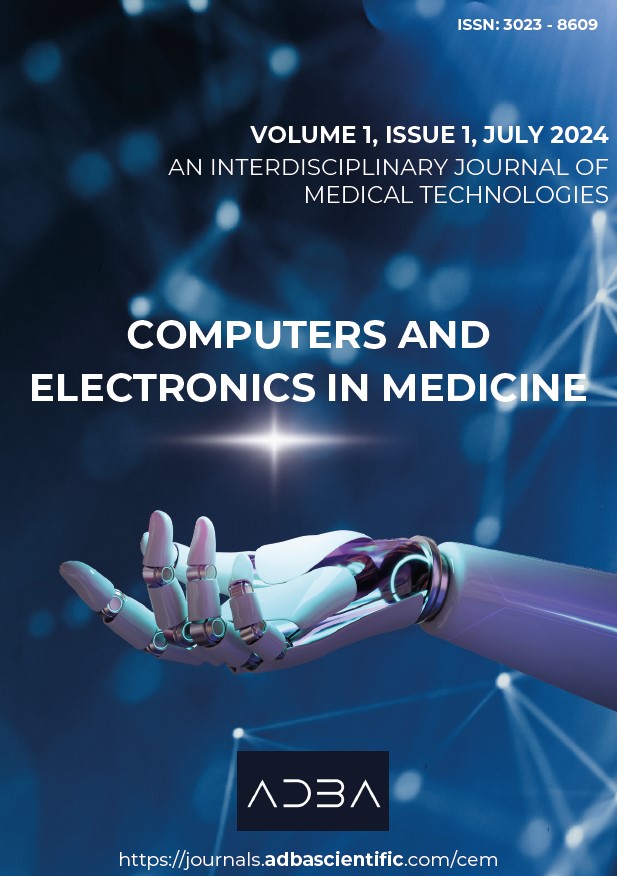Abstract
In this study, the utilization of artificial neural networks (ANN) algorithms, in the diagnosis of neurodegenerative diseases were examined. Data obtained from the measurement of walking parameters were evaluated for disease diagnosis using the ANN model among individuals with ALS, Parkinson's, Huntington's, and healthy individuals. Comparative analyses conducted using Levenberg-Marquardt, Bayesian Regularization, and Scaled Conjugate Gradient algorithms demonstrate that the Levenberg-Marquardt algorithm provides the most effective diagnosis with a success rate of 99%. This study highlights the potential of artificial neural networks in the early diagnosis of neurodegenerative diseases and lays a foundation for future research. In conclusion, artificial neural networks may play a significant role in the diagnosis of neurodegenerative diseases, but further research and method development in this area are warranted.
References
Akalan, N. E. and Y. Temelli, 2014. Serebral parezide gözlemsel yürüme analizinin yeri ve kullanılabilirliği. Sağlık Bilimleri ve Meslekleri Dergisi 1: 28–45.
Aslan, D. H., M. E. Hernandez, M. L. Frechette, A. T. Gephart, I. M. Soloveychik, et al., 2021. The neural underpinnings of motor learning in people with neurodegenerative diseases: A scoping review. Neuroscience Biobehavioral Reviews 131: 882–898.
Balaji, E., D. Brindha, and R. Balakrishnan, 2020. Supervised machine learning based gait classification system for early detection and stage classification of parkinson’s disease. Applied Soft Computing 94: 106494.
Bart, v. V., 2018. Variability in neuromotor control of the musculoskeletal system dynamics: a stochastic modelling approach. Ph.D. thesis.
Bates, G. P., R. Dorsey, J. F. Gusella, M. R. Hayden, C. Kay, et al., 2015. Huntington disease. Nature Reviews Disease Primers 1: 15005.
Berke Erdaş, E. Sümer, and S. Kibaroglu, 2022. Cnn-based severity prediction of neurodegenerative diseases using gait data. Digital Health 8: 20552076221075147.
Burke, R. E., A. M. Degtyarenko, and E. S. Simon, 2001. Patterns of locomotor drive to motoneurons and last-order interneurons: clues to the structure of the cpg. Journal of Neurophysiology 86: 447–62.
Cimolin, V. and M. Galli, 2014. Summary measures for clinical gait analysis: A literature review. Gait Posture 39: 1005–1010.
Fahn, S., 2003. Description of parkinson’s disease as a clinical syndrome. Annals of the New York Academy of Sciences 991: 1–14.
Güler, H. C., 2011. Yürüyüş analizi: Temel kavramlar ve uygulama. In Fiziksel Tıp ve Rehabilitasyon, edited by M. Beyazova and Y. G. Kutsal, pp. 401–26, Güneş Tıp Kitabevi, second edition.
Gültekin, M. and A. Ekinci, 2017. Huntington hastalığında dikkat fonksiyonlarının değerlendirilmesi. Dicle Tıp Dergisi 44: 365–71.
Hausdorff, J. M., A. Lertratanakul, M. E. Cudkowicz, A. L. Peterson, D. Kaliton, et al., 2000. Dynamic markers of altered gait rhythm in amyotrophic lateral sclerosis. Journal of Applied Physiology 88: 2045–2053.
Kaczmarczyk, K., A. Wit, M. Krawczyk, and J. Zaborski, 2009. Gait classification in post-stroke patients using artificial neural networks. Gait Posture 30: 207–210.
Kaya, A. and F. Özcan, 2017. Amiyotrofik lateral skleroz (ALS) hastalarıyla iletişim ve güncel teknolojiler. The Journal of Turkish Family Physician 8: 43–48.
Marsden, C. D., 1994. Parkinson’s disease. Journal of Neurology, Neurosurgery and Psychiatry 57: 672–681.
McColgan, P. and S. J. Tabrizi, 2018. Huntington’s disease: a clinical review. European Journal of Neurology 25: 24–34.
Pallone, J. A., 2007. Introduction to parkinson’s disease. Disease-a-month 53: 195–199.
Prabhu, P., A. K. Karunakar, H. Anitha, and N. Pradhan, 2020. Classification of gait signals into different neurodegenerative diseases using statistical analysis and recurrence quantification analysis. Pattern Recognition Letters 139: 10–16.
Setiawan, F., A. B. Liu, and C. W. Lin, 2022. Development of neurodegenerative diseases’ gait classification algorithm using convolutional neural network and wavelet coherence spectrogram of gait synchronization. IEEE Access 10: 38137–38153.
Shetty, S. and Y. S. Rao, 2016. SVM based machine learning approach to identify parkinson’s disease using gait analysis. In 2016 International Conference on Inventive Computation Technologies (ICICT), volume 2, pp. 1–5, IEEE.
Shi, B., A. Tay, W. L. Au, D. M. Tan, N. S. Chia, et al., 2022. Detection of freezing of gait using convolutional neural networks and data from lower limb motion sensors. IEEE Transactions on Biomedical Engineering 69: 2256–2267.
Turner, M. R. and M. Benatar, 2015. Ensuring continued progress in biomarkers for amyotrophic lateral sclerosis. Muscle Nerve 51: 14–18.
Yavuzer, G., 2014. Yürüme analizi ve temel kavramlar. Türk Ortopedi ve Travmatoloji Birliği Derneği Dergisi 13: 304–308.
Yuldashev, U., 2022. Correlation networks of spinal motor neurons that innervate lower limb muscles during a multi-joint isometric task. The Journal of Physiology.
Yücelbaş, C. and Yücelbaş, 2019. Çift yoğunluklu 1-d dalgacık dönüşümü kullanılarak parkinson hastalığının yaş faktörüne göre tespit edilmesi. Avrupa Bilim ve Teknoloji Dergisi pp. 881–887.
Öztürk, K. and M. E. Şahin, 2018. Yapay sinir ağları ve yapay zekâ’ya genel bir bakış. Takvim-i Vekayi 6: 25–36.

This work is licensed under a Creative Commons Attribution-NonCommercial 4.0 International License.

